Posted by Anita on 03.16.08 10:01 AM
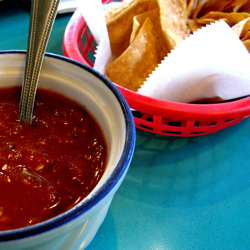 My Dark Days Challenge cohorts, please avert your eyes: With the exception of two or three breakfasts, there was absolutely nothing sustainable, local, or even organic about the way we spent our long Presidents Day weekend. Que lastima — we traded local for loco, spending a crazy four days eating nothing but Mexican food.
My Dark Days Challenge cohorts, please avert your eyes: With the exception of two or three breakfasts, there was absolutely nothing sustainable, local, or even organic about the way we spent our long Presidents Day weekend. Que lastima — we traded local for loco, spending a crazy four days eating nothing but Mexican food.
Since time was limited on Friday morning before work, we headed to an old standby. Los Jarritos has been the scene of more Sunday breakfasts than we can count, and one or two dinners over the years. The coffee is terrible, so stick with the Mexican chocolate, and the chilaquiles are limp and over-egged. But it’s hard to complain too much about a place that serves homemade tortillas, and the service is always so adorably welcoming that we’re more than a little forgiving of Jarritos’ shortcomings.
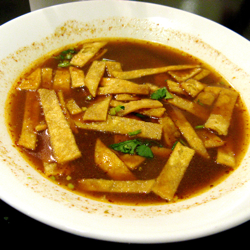 Maybe it’s was a case of diminished expectations, but I have to say that my lunch at Frontera Fresco on the lower level of Macy’s Union Square was not nearly the dreck-fest I was expecting after reading some early critiques. Yes, it’s corporate chain food — think Wolfgang Puck Express goes to Mexico — but it’s certainly no travesty.
Maybe it’s was a case of diminished expectations, but I have to say that my lunch at Frontera Fresco on the lower level of Macy’s Union Square was not nearly the dreck-fest I was expecting after reading some early critiques. Yes, it’s corporate chain food — think Wolfgang Puck Express goes to Mexico — but it’s certainly no travesty.
It might be too strong to say that I enjoyed my meal, but I was served a thoroughly decent, well-garnished bowl of tortilla soup, and an unorthodox (but not unpleasant) chicken torta. I laughed out loud at the sandwich’s sundried tomato garnish, and its lettuce seemed to be dressed in Good Seasons Zesty Italian. But everything else was in the ballpark: rich frijoles, tinga-style chicken, and a chunky slab of queso añejo. Don’t get me wrong: It’s not fabulous, and it’s definitely not worth a special trip, but there are certainly worse ways to spend your $10 downtown. And I’d be downright ecstatic to find a Frontera Fresco branch in an airport.
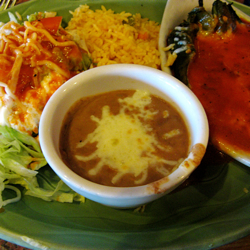 Friday afternoon, I hopped a southbound CalTrain after work. Cameron picked me up at Mountain View station and in just a few moments we were pulling into the parking lot of our favorite Mexican restaurant, Fiesta del Mar. Our friends Jason and Margaret introduced us to this fabulous place way back in the day — more than a decade ago, now — and we’ve been coming here religiously ever since. Sure it’s crazy to drive an hour to go to dinner, but such is our devotion.
Friday afternoon, I hopped a southbound CalTrain after work. Cameron picked me up at Mountain View station and in just a few moments we were pulling into the parking lot of our favorite Mexican restaurant, Fiesta del Mar. Our friends Jason and Margaret introduced us to this fabulous place way back in the day — more than a decade ago, now — and we’ve been coming here religiously ever since. Sure it’s crazy to drive an hour to go to dinner, but such is our devotion.
And we’re not the only fans: Plaques on the wall attest to the restaurant’s enduring popularity: They’ve been voted “Best Mexican Restaurant” by the local paper every year but one since the early 1990s. They’re justly famous for their shrimp dishes — Cameron loves their Camarones Alex and the Camarones a la Diabla — but I love them for their great margaritas (El Jimador, rocks, salt… thanks!) and their unbattered chiles rellenos. There’s almost always a line out the door, but the tables turn quickly and you won’t regret the wait.
 Saturday morning found us at our usual spot: The Ferry Plaza farmers market, and specifically the Primavera stand. Although this market favorite offers chilaquiles nearly every Saturday, they mix things up a little by varying the sauce; one week it’s a green tomatillo-serrano blend, the next it’s a tomato-chipotle salsa, and the next it might be a puree of guajillo chiles (as it was that weekend).
Saturday morning found us at our usual spot: The Ferry Plaza farmers market, and specifically the Primavera stand. Although this market favorite offers chilaquiles nearly every Saturday, they mix things up a little by varying the sauce; one week it’s a green tomatillo-serrano blend, the next it’s a tomato-chipotle salsa, and the next it might be a puree of guajillo chiles (as it was that weekend).
A plate of salsa-sauteed chips served with Cameron’s all-time favorite soft-scrambled eggs and some pretty delicious black beans… ahh, brunchly perfection. Of course, we couldn’t resist ordering a plate of tacos al pastor — and its perfect pairing, piña agua fresca. Weighted down by our mega-breakfast, we wandered our way around the market, vainly trying to work off our stuffedness while finishing our weekly shopping.
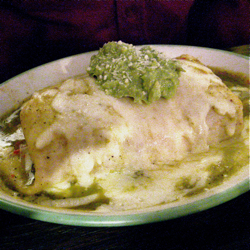 Not surprisingly, we weren’t hungry again until dinnertime. After the sun set, we made our way to the Daly City border to check out a little hole-in-the-wall we’d heard good things about. Lisa’s Mexican Restaurant looks like a biker bar from the outside, with its microscopic windows, spotlit sign, and ugly burglary bars facing Mission Street.
Not surprisingly, we weren’t hungry again until dinnertime. After the sun set, we made our way to the Daly City border to check out a little hole-in-the-wall we’d heard good things about. Lisa’s Mexican Restaurant looks like a biker bar from the outside, with its microscopic windows, spotlit sign, and ugly burglary bars facing Mission Street.
But when you step inside, you’re entering another world. Every surface but the floor is covered with goofy stuff — photos of old Mexican movie stars, life-size parrots, oversized sombreros, and creepy paintings of big-eyed children. The overall effect is like dining inside some crazy abuela’s closet, but somehow it feels cozy, not chaotic. The welcome is friendly, both from the staff and the other patrons. And the food…
Well, honestly, I don’t want to get your hopes up. Lisa’s is decidedly not gourmet, and it definitely isn’t in the same league as Fiesta del Mar. But if you’re a homesick Southern Californian pining for the cheesy combo-plates of your youth, Lisa’s will fill your heart and belly in a way that you’ve never experienced north of the Grapevine. Their chile relleno sauce is just right (it’s the kind with chunks of celery like you see absolutely everywhere in L.A.) and their crispy tacos are dynamite. The best thing we’ve had at Lisa’s — and I am embarrassed to admit, we’ve been back almost every week since we discovered it – is their chile verde. Cameron likes to ask for it in their Lisa’s Especial, a football-sized ‘wet’ burrito stuffed with everything a homesick Angeleño needs to feel right again.
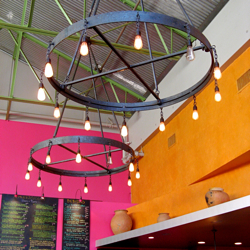 Sunday we crossed the bridge for brunch at our East Bay fave, Tacubaya. The spinoff of Temescal’s oft-lauded Doña Tomás, this taqueria — tucked behind Sur La Table and Café Rouge on Berkeley’s Fourth Street restaurant row — lures breakfasters into gorgeous skylit space decked out in tropical-fruit colors and natural wood surfaces. It’s a neighborly place, albeit one with a very calculated and upscale vibe, and though the crowds come out in force, the line moves fast and there’s never much of a wait for a table.
Sunday we crossed the bridge for brunch at our East Bay fave, Tacubaya. The spinoff of Temescal’s oft-lauded Doña Tomás, this taqueria — tucked behind Sur La Table and Café Rouge on Berkeley’s Fourth Street restaurant row — lures breakfasters into gorgeous skylit space decked out in tropical-fruit colors and natural wood surfaces. It’s a neighborly place, albeit one with a very calculated and upscale vibe, and though the crowds come out in force, the line moves fast and there’s never much of a wait for a table.
No matter what time of day we visit, we can never resist an order of churros y chocolate; other breakfast fare mostly starts and stops with so-so chilaquiles and decent variations on huevos, plus menudo on weekends. Like its O-Town sibling, Tacubaya bases its menu on local produce and sustainable meat.
 Later in the day, we took a long-overdue tour of Oakland’s taco-truck scene. We used to love planning day-long taco crawls with our Seattle crew, and when we first moved back to San Francisco, we tried to get our new friends to follow suit. Various circumstances conspired against us — ranging from a surreal bout of foul weather to half the group catching one of those pandemic colds — and eventually we gave up trying to get everyone across the bay at the same time. But I’d kept my notes, adding a truck here or a cart there from time to time, and waited for the right day. And now that day had come.
Later in the day, we took a long-overdue tour of Oakland’s taco-truck scene. We used to love planning day-long taco crawls with our Seattle crew, and when we first moved back to San Francisco, we tried to get our new friends to follow suit. Various circumstances conspired against us — ranging from a surreal bout of foul weather to half the group catching one of those pandemic colds — and eventually we gave up trying to get everyone across the bay at the same time. But I’d kept my notes, adding a truck here or a cart there from time to time, and waited for the right day. And now that day had come.
We started out at the corner of 22nd and International, at a former A&W Drive-In that’s now home to not one but two taco trucks. Tacos Sinaloa features the usual assortment of meats — carnitas, chorizo, carne asada, and such — ensconsed in the eater’s choice of tacos, burritos, tortas and more. Across the parking lot, Mariscos Sinaloa offers all these plus fish tacos, tostadas de ceviche, and other seafood-based items. I opted for a taco full of deliciously meaty carnitas; Cameron had a muy sabroso shrimp taco from the other truck. Off to a good start, we ate our way up and down the boulevard, stopping at any truck where we saw more than two people in line. Our favorites: El Grullo’s tacos al pastor, Tacos Guadalajara’s shredded carnitas, and the cabeza at El Novillo in the shadow of Fruitvale BART.
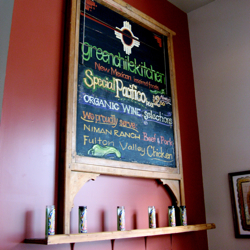 Monday is a hard day to find Mexican breakfast in the City; many family-run businesses take the day off after their weekend rush. We didn’t want to repeat ourselves, so we headed to Green Chile Kitchen over in NoPa. It’s the kind of storefront cafe you find in nearly every San Francisco neighborhood: Wood tables, tall windows, a chalkboard menu, and a tall counter where you place your order.
Monday is a hard day to find Mexican breakfast in the City; many family-run businesses take the day off after their weekend rush. We didn’t want to repeat ourselves, so we headed to Green Chile Kitchen over in NoPa. It’s the kind of storefront cafe you find in nearly every San Francisco neighborhood: Wood tables, tall windows, a chalkboard menu, and a tall counter where you place your order.
Sadly, the food’s no better than average, and it’s definitely Southwestern rather than Mexican. But they use quality ingredients (mostly organic produce, Niman Ranch meats, and Fulton Valley chicken) and there’s good coffee, easy street parking, and a pleasant little vibe.
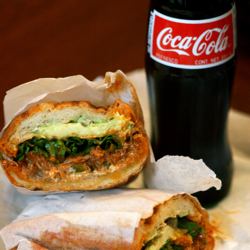 As we were leaving NoPa, the once-cloudy day turned sunny, so we grabbed the dogs and headed back to the Mission. There’s nothing better on a bright winter afternoon than a lazy meander down the eastern stretch of 24th Street, where you can walk and shop for hours without hearing a single word of English. When we’d finally gotten our appetites back, Cameron entertained the pups while I popped into Tortas Los Picudos, a cheerful slice of chaos where they sell grilled Mexican sandwiches and licuados (which many shops translate as “milkshakes” although they’re really more like smoothies).
As we were leaving NoPa, the once-cloudy day turned sunny, so we grabbed the dogs and headed back to the Mission. There’s nothing better on a bright winter afternoon than a lazy meander down the eastern stretch of 24th Street, where you can walk and shop for hours without hearing a single word of English. When we’d finally gotten our appetites back, Cameron entertained the pups while I popped into Tortas Los Picudos, a cheerful slice of chaos where they sell grilled Mexican sandwiches and licuados (which many shops translate as “milkshakes” although they’re really more like smoothies).
Fillings at Los Picudos run the gamut from basic ham-and-American or turkey-and-Swiss to belly busters like the Cubana. A very distant relation to the medianoche you may be used to, Los Picudos’ porcine homage to La Isla includes roast pork, ham, queso fresco, lettuce, jalapeños, mayonnaise, butter… and a foot-long hotdog! We wisely chose to split a spicy pulled-pork torta, and picked up a Mexican Coke at Casa Lucas on our way back up the block.
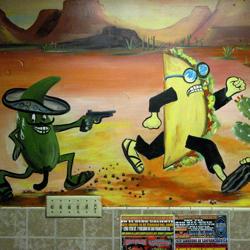 By the time we were hungry again, our options on a Monday night had diminished to a handful of late-night taquerias. Wanting to make sure we ended our weekend of gluttony on a high note, we popped down the hill to our nearby favorite, El Gran Taco Loco. Sandwiched in between a hard-liver bar and our local branch of Cole Hardware, Taco Loco has won our hearts despite its interrogation-room lighting, uncomfortable booths, and goofball murals.
By the time we were hungry again, our options on a Monday night had diminished to a handful of late-night taquerias. Wanting to make sure we ended our weekend of gluttony on a high note, we popped down the hill to our nearby favorite, El Gran Taco Loco. Sandwiched in between a hard-liver bar and our local branch of Cole Hardware, Taco Loco has won our hearts despite its interrogation-room lighting, uncomfortable booths, and goofball murals.
We long ago discovered that the burritos and other semi-Americanized offerings at Taco Loco aren’t much to write home about, but their tacos — and most specifically, their carnitas tacos — are a thing of beauty and a joy forever. (Or at least the next 4 to 6 hours.) Cameron’s a huge fan of their birria, — a goaty, dark-chile-flavored soup that’s good for whatever ails you on a Sunday morning. But for our last meal of the long weekend, we kept it simple: A carnitas super-taco for me, and a buche taco for the bald guy. It certainly wasn’t the best meal of the bunch, but a late-night snack at our neighborhood favorite was definitely a fitting end to a gastronomical journey that spanned three area codes.
Los Jarritos
901 South Van Ness
San Francisco, CA 94110
415 648.8383
Frontera Fresco
170 O’Farrell Street, Macy’s basement level
San Francisco, CA 94103
415 296.4349
Fiesta del Mar
1005 N. Shoreline Blvd
Mountain View CA 94043
650 965.9354
Primavera
Ferry Plaza Farmers Market (Embarcadero at Market)
San Francisco, CA
Lisa’s Mexican Restaurant
6582 Mission Street (near John Daly Blvd)
Daly City, CA 94014
650 756.6289
Tacubaya
1788 4th Street
Berkeley, CA 94710
510 525.5160
Tacos Sinaloa / Mariscos Sinaloa
International Blvd & 22nd Avenue
Oakland, CA 94601
El Grullo
International Blvd & 26th Avenue
Oakland, CA 94601
Tacos Guadalajara
International Blvd & 44th Avenue
Oakland, CA 94601
Tacos El Novillo
1001 Fruitvale Avenue
Oakland, CA 94610
Green Chile Kitchen
601 Baker Street
San Francisco, CA 94117
415 614.9411
Tortas Los Picudos
2969 24th Street
San Francisco, CA 94110
415 824.4199
El Gran Taco Loco
3306 Mission Street
San Francisco, CA 94110
415 695.0621
breakfast, downtown SF, East Bay, Mexican, restaurants, The Mission
12 Comments »




Posted by Anita on 01.13.08 2:08 PM
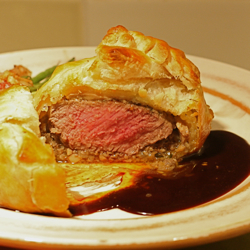 Suffice to say that we had such a relaxing time on our vacation that it’s taking us an inordinately long time to get back in the swing of things. We’ve been home nearly 2 weeks now, and I am finally getting my head out of the clouds long enough to tell you about all the gorgeous food we ate.
Suffice to say that we had such a relaxing time on our vacation that it’s taking us an inordinately long time to get back in the swing of things. We’ve been home nearly 2 weeks now, and I am finally getting my head out of the clouds long enough to tell you about all the gorgeous food we ate.
Our 10 days away — in a little cottage in the foothills above Napa Valley — were incredibly relaxing. We brought along two coolers full of food from the farmers market (our landlord eyed the back of our car and quipped, “You know, we do have grocery stores here…”) and we spent nearly every day sitting by the fire, catching up on our reading, and cooking amazing food.
The day we drove up, we bought a pair of enormous Dungeness crabs from Shogun fish on their last market day of the season. The first night in our little cottage, Cameron picked the crabs and we sauteed the meat in Spring Hill Farm butter along with some zest from our backyard lemons and a few slices of green onions. Served over Eduardo’s linguine, with a salad and a split of Schramsberg sparkling wine, it was the perfect settling-in meal.
Of course, there was plenty of leftover crab meat! The next day, we turned part of it into crab omelettes for brunch, then mixed the rest into a sumptuous batch of fondue mac-and-cheese. Monday night, we whipped up a 100% local batch of Jen’s chicken cacciatore with an heirloom chicken from Prather and some Far West Funghi chanterelles, served over Full Belly Farm polenta with a bottle of Calistoga Cellars Zinfandel.
Tuesday night was Christmas supper: Mini beef Wellingtons! Prather Ranch filet mignon wrapped in puff pastry with a slice of Fatted Calf foie gras and duxelles made from Far West cremini mushrooms, Spring Hill butter, and Straus cream. On the plate: A sauce of red-wine-infused demiglace (homemade from Prather bones) and a side of Iacopi green beans quick-braised with Fatted Calf pancetta. We drank a bottle of Cabernet from Mount Veeder Winery, just a few miles down the road from our cottage.
Wednesday night, we turned to our usual lazy-day standby: Pasta Bolognese with a big green salad. Thursday we took the night off from kitchen duty, and headed down the hill for a gorgeous sushi-fest at Go Fish. By Friday, we were ready to cook again: We pulled the last of our homemade spiral sausage out of the freezer and served it along with cauliflower soup made from farmers market veggies and a mixture of orphan pieces from the local cheese plate we’d been nibbling all week.
Saturday night Cameron made an improvised braise of Prather beef cheeks, with homemade beef stock, home-canned tomatoes, and herbs from the garden. Served with more Full Belly polenta and some Ella Bella broccoli rabe, it was the perfect supper for the chilliest night of our trip.
Sunday night, we began prepping our traditional New Year’s cassoulet. While the stovetop was occupied simmering Rancho Gordo beans, searing Toulouse sausages, and cooking off Fatted Calf duck confit, we used the oven to roast a most gorgeous Range Brothers pork rib roast. An unorthodox recipe for potato gratin — started on the stovetop and finished in the oven while the roast rested — turned out beautifully… a perfect showcase for Little’s potatoes, Bellwether Farms cheese, and Clover dairy. We usually roast our Brussels sprouts, but because our baby oven couldn’t accommodate a roast and a side dish, we tried a new-to-us method: Sauteeing the shredded sprouts in rendered pancetta fat, and adding the crisped pork back to the finished dish at the end. (We loved it so much, we’re having it again tonight.)
Monday night — New Year’s eve — meant it was finally time to break into the cassoulet that had been tempting us with its luscious smells for the last 24 hours. A rough-but-tasty bottle of Pinot Noir and a big salad were all we needed to round out its delicious pork-infused goodness.
Packing the next morning was almost impossibly hard; our little kitchen had served us so well for our 10 days away! Unlike most rental houses, this one was well stocked with high-end cookware and thoughtful staples (organic eggs and Bouchon pastries awaited us our first morning). But the ultimate luxury was having the time to putter in the kitchen all day, every day. The space was cozy, and the equipment a bit spare, but it was such a treat to forget about the office, the phone, and all of our usual distractions for a few days and cook together.
We planned all along to keep up with the Dark Days challenge while we were gone, but looking back over our photos, we were surprised at just how well we’d done. With the exception of cocktails, a few lunches out, and our one in-town dinner, everything we ate and drank during our trip came from local sources. Getting to the 90% local, five-nights-a-week mark has become pretty achievable for us on a regular basis. It’s comforting to know we could get to 100% local — given unlimited time to plan, to shop, to cook — even if it’s not something we’re able to do in the workaday world.
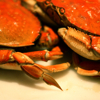
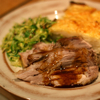

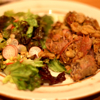
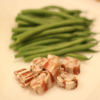
Now, in theory, the Dark Days challenge wrapped up at the end of last year, with an optional extension into 2008. We’re having such a ball, we’ve decided to continue with the challenge, along with more than 20 other participants. Because our hostess, Laura, is in the midst of moving her house (and her chickens!), official wrap-ups will taper off to every two weeks.
Because it’s a new year, we’re going to make some changes to our own ground rules, too. Here’s our revised game-plan:
- We will continue to cook locally as often as we can, with a baseline of two dinners per week made from 90% local ingredients.
- We will write about
at least two meals a week made with as many local ingredients as we can source. our locavore adventures regularly, but we’re going to dispense with the litany of meals and sources, as it’s getting rather repetitious and a bit boring for non-locavore readers. We WILL talk about new pantry items, new farmers we’ve discovered, and recipes for in-season items within our foodshed.
- Local for us will be a 100-mile radius for produce and a 200-mile radius for protein. We will try to keep our protein within a 50- to 100-mile radius at least twice a week. Strong preference will be given to items purchased directly from farmers at market rather than retail. Our protein will include pastured eggs, poultry, and pork, as well as grass-fed beef. When grass-fed is not available or not appropriate, we will use 100% humanely raised, pastured beef. (I find grass-fed beef too gamey in grilled or stir-fried preparations, but for braises and stews, it’s our new default.)
- We’re making the usual ‘Marco Polo’ exemptions for seasonings.
We’re also making exceptions for flour, dried pasta, white rice, and polenta — we have no local sources of these ingredients, and man does not live by potatoes and bread alone. We will try to source baking ingredients locally, but I don’t expect to find much beyond nuts, and I won’t go through the holidays without baking. (We’ve found local sources for all of our grains.)
- We’ll try to limit processed and prepared foods to those produced within a 50-mile radius. We’ll try to determine how much local ingredient sourcing they’re doing, and talk about it in our posts.
- We’ll continue with the challenge through the end of
the year, and then re-evaluate on New Year’s Day along with other participants. March.
Dark Days challenge, locavore, Napa & Sonoma, travel
6 Comments »




Posted by Anita on 01.09.08 8:03 AM
 Once upon a time, there was a Chef who toiled away in other people’s kitchens. After gaining acclaim for a rare skill with classic preparations, the Chef moved to Napa Valley and opened a signature restaurant on the fringe of the sleepy village of Yountville.
Once upon a time, there was a Chef who toiled away in other people’s kitchens. After gaining acclaim for a rare skill with classic preparations, the Chef moved to Napa Valley and opened a signature restaurant on the fringe of the sleepy village of Yountville.
Soon, visitors flocked to the Valley not just to drink, but also to dine. An award-winning cookbook soon followed, then another cozier restaurant just down the road. The ensuing years brought more praise from the press, another cookbook, still more awards. Never content to rest on culinary laurels, the Chef recently opened a third restaurant aimed at a broader audience.
Think that you know this story? Not so fast. The hero of this particular tale is a woman, and the plot begins not in 1997 at The French Laundry with Thomas Keller, but in the dark ages of 1983 at a “truck stop deluxe” along Highway 29 known as Mustards Grill.
Before making history at Mustards, Cindy Pawlcyn made her name at the once-enthralling (but now sadly coasting) Fog City Diner. One of the first to popularize the conceit of comfort food as true cuisine, FCD was among the vanguard of New American restaurants. Pawlcyn was praised for her efforts there, and the cookbook she wrote remains a classic of the comfort-luxe genre.
When Pawlcyn took her jumped-up homespun specialties to Yountville, the national press knew she was onto something special. “[Mustards] changed Napa Valley and took the stuffiness out of dining,” said Gourmet magazine. Pawlcyn was soon in high demand, serving as chef and/or consultant to a string of well-known ventures, including San Francisco’s Bix, Marin’s Buckeye Roadhouse and Napa’s Tra Vigne. The Mustards Grill Napa Valley Cookbook won a James Beard Award, and it remains a perennial favorite in our kitchen (and many others, to judge from our friends’ bookshelves).
Pawlcyn eventually sold her share in the Real Restaurants empire to focus solely on Mustards, but with the 2001 takeover of St. Helena’s Miramonte, she again became a multi-location chef. Morphing into the less-threatening Cindy’s Backstreet Kitchen in 2003, this outpost continues to draw crowds — a happy success in a region where fickle diners often disappear as quickly as they came.
—-
We’ve eaten at most of Cindy Pawlcyn’s restaurants, including a good dozen visits to Mustards over the years, although a recent lunch there with family left me wondering if the 25-year-old landmark was feeling its age. The four of us ordered an assortment of options; none of our choices really wowed, and a few truly bombed. Months later, I grimace to recall a plate of greasy onion rings, and a pulled-pork sandwich with bland meat under a nearly inedibly sweet, heavily spiced sauce.
Happily, Pawlcyn’s two other ventures are as good as Mustards ever was in its prime.
We’ve returned to Cindy’s Backstreet Kitchen three times in as many trips north — twice last summer, and then once again last month. The food is old-school American with judicious flashes of Asian and Latin spark. If, like me, you’re a fan of Pawlcyn’s latest cookbook, Big Small Plates, you’ll find yourself equally taken with the dining room where many of its recipes first appeared. The decor evokes a gorgeous farmhouse, with a California crispness and vibrant splashes of Wine Country color. A long bar forms the centerpiece of the front dining room, a metaphor brought home by a clever cocktail list that weaves farm-fresh produce into a collection of delectable drinks.
In early 2007, Pawlcyn launched what is now her largest outpost: Go Fish. A “West Coast seafood house” along Highway 29, Go Fish is paradoxically cavernous but cozy, a coup that owes much to successful decor and lighting. The menu includes both traditional and modern seafood plates, but — as you might expect from a kitchen under the auspices of sushi master Ken Tominaga — the raw fish options are its stunning centerpiece. We visited over the holiday and out of a dozen nigiri and a few specialty rolls we sampled, only one (the kitchen’s very last portion of ikura, which we should have known better than to pounce upon) was less than sublime.
As lovely as Go Fish is, though, it’s too dear for everyday. It’s all too easy to spend hundreds of dollars on dinner for two, especially if you make a meal of the amazing sushi… which I highly suggest you do. Happily, there are many different ways to experience the inspired cuisine of the other — one might even say the original — Napa dining dynasty.
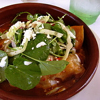
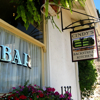

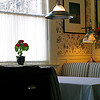
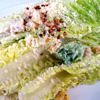
Cindy’s Backstreet Kitchen
1327 Railroad Avenue
St. Helena, CA 94574
707.963-1200
Go Fish
641 Main Street
St. Helena, CA 94574
707.963-0700
Mustards Grill
7399 St. Helena Highway
Yountville, CA 94558
707.944-2424
cookbooks, Napa & Sonoma, restaurants
5 Comments »




Posted by Anita on 11.02.07 8:59 AM
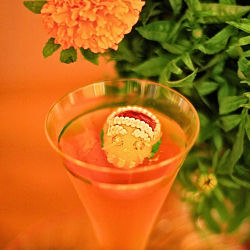 Dia de Los Muertos, or the Day of the Dead, is a bit of a misnomer, especially in Mexico where the festivities are often spread out over two or more days. Like most Latino holidays of a spiritual sort, this fiesta integrates indigenous traditions alongside Catholic feasts, blending traditional pre-Hispanic ancestor worship with the Europeans’ All Saints Day and All Souls Day. Children and other innocents are remembered on November 1, and those who died as adults are honored the next day and night. As someone for whom death is a relatively fresh memory, setting aside a few days to remember those we have lost seems eminently wise, a useful way of mourning together and acknowledging individual loss as part of a universal experience.
Dia de Los Muertos, or the Day of the Dead, is a bit of a misnomer, especially in Mexico where the festivities are often spread out over two or more days. Like most Latino holidays of a spiritual sort, this fiesta integrates indigenous traditions alongside Catholic feasts, blending traditional pre-Hispanic ancestor worship with the Europeans’ All Saints Day and All Souls Day. Children and other innocents are remembered on November 1, and those who died as adults are honored the next day and night. As someone for whom death is a relatively fresh memory, setting aside a few days to remember those we have lost seems eminently wise, a useful way of mourning together and acknowledging individual loss as part of a universal experience.
The celebration — somehow more intimate and yet more festive than Halloween — gives people time to openly remember their dearly departed, and many Mexican and Mexican-American families erect memorial altars in their homes. These ofrendas typically feature a photo of the deceased surrounded by candles, glasses of water, vases of marigolds, small statues of saints or skeletons, decorated sugar skulls, and plenty of food. In addition to the rich bread known as pan de muerto, altar offerings often include moles or other fragrant dishes, bottles of beer or tequila, and other treats to tempt the spirits of the departed to return for a visit home.
Not far from our house, the streets around 24th and Mission are filled with shoppers stocking their altars: The craft stores sell skeleton figurines and papel picado, the florists put out bunches and buckets of marigolds, the panaderias set up tables of pan de muertos on the sidewalk, and the smell of incense fills the air. The mood is festive and the decorations colorful, and tonight, there’ll be a festive parade through the heart of the Mission. What a civilized way to celebrate life’s ultimate certainty.
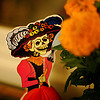
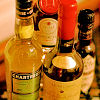

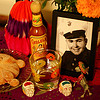
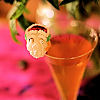
One of the most recognizable symbols of the fiesta is La Calavera de la Catrina, the fancy-lady skeleton. As with many macabre figures in Mexican folk art, La Catrina serves as a reminder that death comes for us all, even the well-to-do and the beautiful. But La Catrina doesn’t let her mortality stand in the way of a good time: She dons her best plumed hat and heads out for a jaunty stroll. Although La Catrina is, herself, dead, she looks so much like a storybook widow-in-black that it’s hard to remember that she’s actually the deceased, not the mourner. No wonder she feels so festive! If you catch her in the right moment, she might just give you a…
Widow’s Kiss
1-1/4 oz Calvados or other apple brandy
3/4 oz Benedictine
3/4 oz yellow Chartreuse
2 dashes aromatic bitters
Stir all ingredients with ice, then strain into a chilled cocktail glass. Garnish with a brandied cherry, or a sugar skull.
Drink of the Week, drinks, holidays & occasions, recipes, The Mission
4 Comments »




Posted by Anita on 09.19.07 11:58 AM
 Back in May, I talked about the Thai cooking classes offered by Kasma Loha-unchit in her Oakland home, and mentioned that “Kasma’s classes, especially the beginning series, are perennially booked”. But if you get a wiggle on, you might be able to score a place in her 2008 classes, which were announced today.
Back in May, I talked about the Thai cooking classes offered by Kasma Loha-unchit in her Oakland home, and mentioned that “Kasma’s classes, especially the beginning series, are perennially booked”. But if you get a wiggle on, you might be able to score a place in her 2008 classes, which were announced today.
Seven sets of the four-class Beginning series, which costs $170, will be offered next spring:
March: Mondays, March 3, 10, 17 & 24
Tuesdays, March 4, 11, 18 & 25
Wednesdays, March 5, 12, 19 & 26
April: Mondays, March 31 & April 7, 14 & 21
May: Tuesdays, May 6, 13, 20 & 27
Thursdays May 8, 15, 22 & 29
June: Mondays, June 2, 9, 16 & 23
There’s more information, including menus, online at Kasma’s site, although the 2008 dates are not yet listed. You can send a request to hold your space to kasma[at]earthlink[dot]net; Kasma’s husband Michael recommends that you send along second- and third-choice series the first time around, as classes really do fill up quickly.
Good luck!
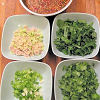
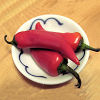
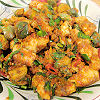
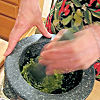

classes, East Bay, Thai
4 Comments »




Posted by Anita on 09.06.07 12:02 PM
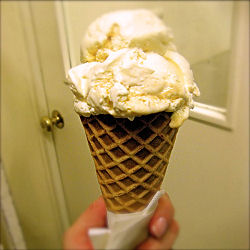 Sure, sure… we’ve all heard the swooning coming from the assembled masses lining up outside Bi-Rite Creamery. (And yes, we’re in awe of their salt-caramel ice cream, just like everyone else.) But waaayyyy down at the other end of The Mission, there’s another ice-cream shop that’s packing them in every night, just like they have since the kids in line sported white bobby socks and greased hair.
Sure, sure… we’ve all heard the swooning coming from the assembled masses lining up outside Bi-Rite Creamery. (And yes, we’re in awe of their salt-caramel ice cream, just like everyone else.) But waaayyyy down at the other end of The Mission, there’s another ice-cream shop that’s packing them in every night, just like they have since the kids in line sported white bobby socks and greased hair.
Although the days when Mitchell’s used milk from its own dairy farm are long gone, each flavor is still made on the premises in small-batch freezers. More than 50 state-fair ribbons and medals on the wall tell the story of the family’s commitment to quality.
You won’t find any honey-lavender or soy-chai scoops here, but that doesn’t mean that Mitchell’s doesn’t get its gourmet groove on. The shop’s biggest claim to fame may be its roster of tropical flavors, sporting tongue-twister names like langka, macapuno, and lucuma, alongside a longer list of ‘standard’ (but still interesting) tastes. Reading the menu’s like a trip around the globe: Thai tea, Mexican chocolate, and New York Cherry are just three options. Feeling cocktailian? Rum raisin, Kahlua, and mojito might do the trick. A set of flavors rotates seasonally; peach holds court today, but pumpkin can’t be far off.
Go ahead, take a number. You’ve got plenty of time to decide…
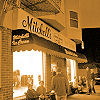
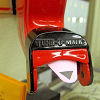
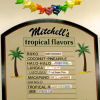
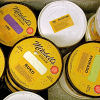
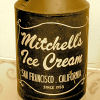
Mitchell’s Ice Cream
688 San Jose Avenue (at 29th)
San Francisco, CA 94110
415 648-2300
dessert, locavore, shopping, The Mission
9 Comments »




Posted by Anita on 06.24.07 8:07 PM
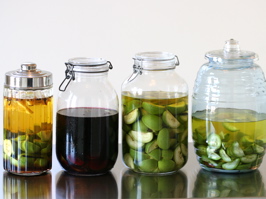 Every June 24, Catholics around the globe celebrate the feast-day of John the Baptist. And every year, on that same day, traditional-minded Europeans head into their local walnut orchards, filling baskets and bags with unripe nuts in order to make nocino, an Italian walnut liqueur, or its French cousin vin de noix.
Every June 24, Catholics around the globe celebrate the feast-day of John the Baptist. And every year, on that same day, traditional-minded Europeans head into their local walnut orchards, filling baskets and bags with unripe nuts in order to make nocino, an Italian walnut liqueur, or its French cousin vin de noix.
We’ve made nocino every summer for the past three years, usually a bit later than the traditional saint’s day due to trouble in our local supply chain. Suffice to say that we lack the necessary ferme, fattoria, or bucolic farmhouse of any sort, and we’ve relied either on nuts shipped from afar or the whimsical schedule of a certain vendor at the Alemany market.
This year, we not only avoided our usual delay, we even jumped the gun a bit. But I hope you’ll agree our motives were good: We were off to Yountville for our anniversary, and I’d remembered reading Shuna’s story last fall about Hoffman Farm, a Napa u-pick with a vast walnut orchard. The idea of making liqueur with nuts we’d plucked ourselves from local trees was simply too attractive to pass up, no matter the date was a tad early.
It took me days to work up the nerve to call John Hoffman and explain what I had in mind. He’d never heard of anyone wanting green walnuts before. “You do know they’re incredibly bitter?” he asked me on the phone. But he graciously allowed that we might stop the coming weekend and pick some nuts, as long as we didn’t come on Sunday morning during church. I assured him that we’d work around his schedule, and would be sure to call before we came, in any case.
Saturday rolled around, bright and sunny. We called Mr. Hoffman to make sure he was home, then donned hats and sunscreen and pointed the car toward Silverado Highway. Just past the intersection with Trancas, we spied the farm’s little sign, a blink-and-miss-it affair. We pulled up the gravel drive and found Mr. Hoffman waiting for us in the shade near his farmhouse garage.
We introduced ourselves and chatted a bit, and he asked me to remind him about what I would do with my early harvest. I explained about splitting the nuts and soaking them in alcohol for most of the summer, then setting aside the strained, sweetened infusion until Christmastime. I marveled that a walnut farmer — and one with Italian in-laws, at that — had never tasted what I’d always assumed was a relatively common homebrew. Not only had he never made it, he’d never even heard of it. Chuckling, he quipped: “Sounds like a waste of a good bottle of vodka,” and winked at Cameron.
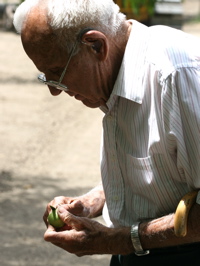 Then he picked up his cane and strolled us out into the orchard. A sun-dappled canopy of walnut boughs stretched as far as the eye could see, all the way back to the crossroads. Mr. Hoffman showed us how to avoid the nuts that suffered from blight — they were few, this early in the season — and how to spy the telltale bore holes of caterpillar infestation. He reached for his pocketknife and cut open one of the few rotten nuts he could find, to show me how the fungus penetrates the hull and works its way to the developing meat.
Then he picked up his cane and strolled us out into the orchard. A sun-dappled canopy of walnut boughs stretched as far as the eye could see, all the way back to the crossroads. Mr. Hoffman showed us how to avoid the nuts that suffered from blight — they were few, this early in the season — and how to spy the telltale bore holes of caterpillar infestation. He reached for his pocketknife and cut open one of the few rotten nuts he could find, to show me how the fungus penetrates the hull and works its way to the developing meat.
It was a botany tutorial, a history lesson, and a glimpse at a disappearing way of life. The Hoffmans have worked this land since the end of World War II. Now, they’re farming one of Napa’s few remaining diversified acreages, as vineyards squeeze out the fruits and nuts that once were the valley’s pride. As Shuna mentions, although the Hoffman land is protected for agricultural use, there’s nothing to prevent these noble trees from being torn out in favor of yet another mass of wine grapes.
After a half hour of picking nuts and snapping photos in the late-morning glow, we brought our canvas sack back to the garage. Mr. Hoffman discussed how to price our unusual transaction while he weighed our haul on his weathered scale. When all was said and done, he refused to take more than a fraction of what we’re used to paying, even when we told him that the going rate was much, much higher. He shook his head like we were citified fools, then added: “You can keep the quarters if you tell me that recipe again.” I smiled broadly and promised to send him prints of the photos we’d taken, plus a few different recipes to try.
We grinned all the way home, amazed at our good fortune in finding Mr. Hoffman — all thanks to Shuna.
After stopping by the local liquor depot for bottles of 100-proof vodka, I quickly set to work halving and quartering the green nuts, measuring sweeteners and spices, and sterilizing my infusing jars. Never had I had the luxury of using nuts picked within hours of infusing, much less 7 pounds worth gathered with my own two hands. Unsurprisingly, we had sufficient nuts for two different batches of nocino — my usual recipe, plus an experiment — as well as a version of Abra’s traditional vin de noix and Lucy’s lighter recipe made with white Burgundy and maple syrup.
I left my quartet of crockery on the new breakfast table for a day or two; they caught the light so beautifully that I wanted to see them (and sneak a sniff of them) all the time. Once the liquids steeped to a black-hole opacity, I followed tradition and put them out in the garden — in this case, the back deck — where they’ll commune with nature for the next 40 days and 40 nights. Then we’ll filter them, bottle them, and wait for the other end of the year, when midwinter brings us yet another celebration of the natural cycle disguised as a religious feast.


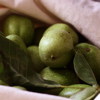
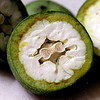

Hoffman Farm
2125 Silverado Trail
Napa, CA 94558
707 226-8938
drinks, holidays & occasions, Italian, locavore, Napa & Sonoma, preserving & infusing
13 Comments »




Posted by Anita on 06.08.07 12:43 PM
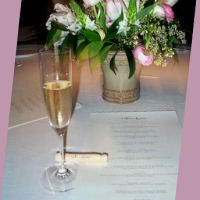
We’ll be away from the blog for a few days. We have an occasion to celebrate, and dinner reservations at a special place tonight. (Please forgive the photo — it was the best of the roll from our last visit in 2005!)
I’m stunned to realize that it’s been more than two years since we visited Wine Country. Is it possible we haven’t been back since we left Seattle? That’s almost as hard as it is to believe that it’s been five whole years ago since we were married, just on the other side of the hills in Sonoma County.
Have a great weekend. I know we will!
holidays & occasions, Napa & Sonoma, restaurants
9 Comments »




Posted by Cameron on 06.06.07 8:40 AM
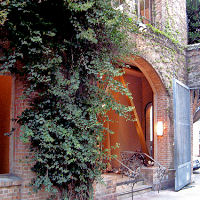 The descriptions of the food, physical locations, and presidential travel are either factual or based on our own experiences. The rest is best described like this…
The descriptions of the food, physical locations, and presidential travel are either factual or based on our own experiences. The rest is best described like this…
Once upon a time, there was a restaurant named Hawthorne Lane. It was a very fine restaurant, with white tablecloths and brightly polished silverware. The restaurant was quiet and serious, with well-mannered waiters who would ask if you cared for another glass of iced tea—served with a miniature pitcher of sugar syrup—or perhaps some more wine.
The restaurant lived on a little stub of an alley that was also called Hawthorne Lane. Hawthorne Lane (the alley, not the restaurant) wasn’t a very large alley, but it was also very fine, with tall brick walls covered with ivy, and arches to walk through.
Hawthorne Lane (the restaurant, not the alley) was successful. It served delicious food to people who dressed well and enjoyed being asked if they cared for another glass of iced tea, or perhaps some more wine. Everyone thought very highly of the restaurant and told it so. One day, the president of the entire country came for lunch, and his big Southern laugh could be heard echoing through the ivy-covered arches.
But one evening—as it watched the light glow through its windows and listened to the thousand tiny clinks of polished silverware—the restaurant noticed something that it had never seen before. While everyone seemed to be enjoying themselves, they also seemed to be working very hard, not just the waiters and the cooks, but even the guests. When they talked, they were careful to keep their voices evenly pitched. Even when they laughed—which happened often, because the restaurant was truly pleasant—they seemed to catch themselves, as if everything that they did needed to be as brightly polished as the wine glasses, as crisply starched as the linens.
When the restaurant realized how hard its guests were working, it became sad. It wondered if being fine and well-mannered made everyone just a tiny bit uncomfortable. And—after much thought—it decided that it would rather be a restaurant where people felt relaxed when they visited.
Away went the white tablecloths and the elegant dining room. In came dark wood paneling and light fixtures that looked like grass skirts made out of tan suede. There was also a chandelier that looked like it was made out of real antlers, because the restaurant thought that it ought to have one thing that was very silly, and the chandelier was very silly indeed.
The waiters were outfitted in T-shirts and sleek trousers. The service was a bit less polished, but it was undeniable that everyone was having more fun, which helped the guests to feel comfortable. The host dressed smartly in a suit and tie, but he also wore canvas sneakers, knowing that it was important to be just a little bit silly. Instead of quiet music, the restaurant played rock-and-roll, including Emotional Rescue by the Rolling Stones, because it liked the part at the end of the song where Mick Jagger talks about riding a horse across the desert.
The restaurant created an interesting cocktail list with lots of inventive drinks. One of the best was a hold-over from the restaurant’s past, a Greyhound-like drink called the Royal Hound with very tiny, very delicious pieces of dried grapefruit stuck to the rim of the glass. The restaurant found a clever wine expert, who created a new wine list with a section of 50 wines priced less than $50 per bottle, because it wanted its guests to feel like they could try different things without worrying about the price.
The restaurant thought that the food on its new menu should be less proper than before, but still interesting and exciting. It greeted each guest with a plate of crunchy, cheesy crackers and small, rich chive biscuits that disappeared so quickly that the restaurant wondered how anyone could possibly eat them so fast.
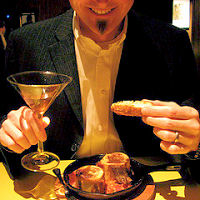
Wanting to serve food that made people feel comfortable, the restaurant offered an absolutely delicious chopped salad, and a tasty wedge of iceberg lettuce with St. Agur blue cheese dressing. There were richer starters, such as potato skins with very good housemade bacon, and deep-fried clam strips with tangy aioli. The appetizer list also included unusual foods like headcheese and marrow bones, both of which were well prepared indeed. One of the visitors didn’t like the tomato sauce that came with his bones, but he happily ate all the marrow anyway.
The restaurant struggled a little bit with its pasta courses; the pappardelle with peas and ricotta was heavy and bland, and the rock-shrimp linguine was rather ordinary. However, the guests liked the spaghetti dressed with uni and breadcrumbs, remarking on how comforting and homey the dish tasted, in contrast to how unusual it sounded.
The restaurant recovered its balance for the main courses. The pork schnitzel was perfectly fried, juicy, and not the least bit greasy; braised lamb cheeks on polenta had at least one person licking the plate. If the hamburger was somewhat dry, at least it was cooked medium-rare all the way through, just the way the guest had asked.
That only left the dessert menu, and the restaurant had to admit that it was puzzled, as one couple absolutely did not like any of their desserts. On one night, they complained that the jelly doughnuts were overfilled. On another night, they said that neither the ice cream nor the cookies in the baby ice-cream sandwiches tasted at all good. The restaurant understood that not every person would like every dish, but it couldn’t understand why these two were so upset when so many other people said nice things about the desserts. But the restaurant was a very wise restaurant and understood that these were small problems. And that there’s no pleasing some folks.
The restaurant has been busy for several months now, content with its new look, new mission, and new name. It is quickly winning new friends, as people visit and tell others that they should go. Some diners are drawn by the buzz, as restaurant-goers often are. Others hold memories of what the restaurant once was, like the young lady who popped in one day looking for the old, elegant, white tablecloth restaurant. Maybe she wanted some of the iced tea served with the little pitcher of sugar syrup. The host in his suit and basketball shoes smiled at her.
“We used to be Hawthorne Lane, but not anymore,” he said. “Now we are Two.”
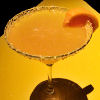


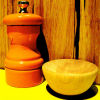

Two
22 Hawthorne Street
San Francisco, CA 94105
415 777-9779
downtown SF, restaurants
1 Comment »




Posted by Anita on 05.31.07 2:04 PM
 I teased you last week with a glimpse into my Tuesday-night classes with Thai cooking maven Kasma Loha-unchit. This most-recent set of classes was the fourth 4-week series I’ve attended; I started with the beginning series nearly 10 years ago, followed up with the intermediate course a few years later, and then — after travelling with Kasma through central and northern Thailand in January 2006 — picked up again with the advanced series last spring.
I teased you last week with a glimpse into my Tuesday-night classes with Thai cooking maven Kasma Loha-unchit. This most-recent set of classes was the fourth 4-week series I’ve attended; I started with the beginning series nearly 10 years ago, followed up with the intermediate course a few years later, and then — after travelling with Kasma through central and northern Thailand in January 2006 — picked up again with the advanced series last spring.
In the beginning series, you master popular curries, simple stir-fries, spicy soups and salads, and authentic (ketchup-free!) pad thai noodles. Even if you think you know a lot about Thai food, you’re sure to learn a lot: You’ll taste-test multiple brands of coconut milk, learn about the best places to buy ingredients, hear the lowdown on the top brands, and get plenty of practice balancing sweet, salty, sour, and hot flavors under Kasma’s watchful eye.
Intermediate classes move on to more labor-intensive preparations, and a larger assortment of ingredients. By the time you reach this level, you’ll have a thorough understanding of flavors and techniques — pounding curry pastes, balancing flavors, frying ingredients in coconut cream — that will put you in good stead for the advanced courses. A total of six advanced series walk students through regional specialties, intricate preparations, and adventurous foodstuffs. Many students work their way through the entire curriculum and then start again — it’s just that much fun to cook alongside other students who are experienced and passionate about Thai food.
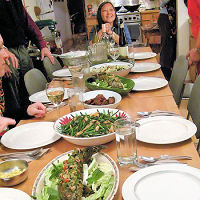 The real joy of learning to cook Thai with Kasma is that she makes Thai cooking accessible without dumbing it down. I hope you won’t think I’m immodest when I say that — even after just the basic courses — I could make Thai food better than what we find at local restaurants. The setup of Kasma’s classes allows for plenty of hands-on work, and lots of time to talk, taste, and learn. Each session starts with a snack while Kasma explains the four to six dishes of the day. Students team up for prep, then gather round as each dish is completed. When the cooking is done, you sit down with Kasma and her charming husband Michael to enjoy the feast you’ve prepared. I promise: You won’t leave hungry.
The real joy of learning to cook Thai with Kasma is that she makes Thai cooking accessible without dumbing it down. I hope you won’t think I’m immodest when I say that — even after just the basic courses — I could make Thai food better than what we find at local restaurants. The setup of Kasma’s classes allows for plenty of hands-on work, and lots of time to talk, taste, and learn. Each session starts with a snack while Kasma explains the four to six dishes of the day. Students team up for prep, then gather round as each dish is completed. When the cooking is done, you sit down with Kasma and her charming husband Michael to enjoy the feast you’ve prepared. I promise: You won’t leave hungry.
Kasma also sells specialized tools and hard-to-find items to her students. Years ago, when I first took the beginning series, her dining-room table was one of the few places to find Thai coffee filters and decent papaya graters. Her offerings have blossomed into a veritable general store of favorite brands and equipment, a useful one-stop-shop when stocking your Asian pantry. Students can also buy from a dwindling stock of Kasma’s award-winning (but out-of-print) cookbooks — Dancing Shrimp and It Rains Fishes — at their original retail price … a big savings over the $40-plus prices you’ll see on Amazon for used copies.
And speaking of bargains: You won’t find a better deal on cooking classes anywhere. Each four-class series costs $160 — just $40 per class, less than you’d probably spend for dinner at your favorite Thai restaurant. Kasma’s house is located close to Oakland’s MacArthur BART station (a quick bus ride or a leisurely half-hour stroll gets you the rest of the way there), making it easy for visitors and bridge-averse City-dwellers to attend. If you live outside the Bay Area, you’re not completely out of luck: Kasma offers week-long intensive sessions each summer for a stunning price: $550. You spend five full days covering territory similar to the beginning and intermediate series, or an assortment of advanced recipes in the later intensives.
Now that I have you salivating, let me disappoint you: You’ll have to be patient. All of Kasma’s classes, especially the beginning series, are perennially booked — and the mention she got in this month’s San Francisco Magazine (alongside Shuna Lydon and June Taylor, among others) will only make matters worse. To finagle a spot, join Kasma’s announcement-only Yahoo group, and be the first to hear about next spring’s offerings.
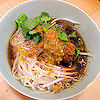
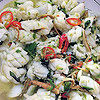
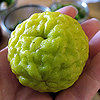
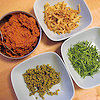
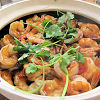
The Art of Thai Cooking
near Piedmont and Grand Avenues
Oakland, CA
510 655-8900
thaifoodandtravel.com
classes, cookbooks, cooking, East Bay, Thai
8 Comments »




 My Dark Days Challenge cohorts, please avert your eyes: With the exception of two or three breakfasts, there was absolutely nothing sustainable, local, or even organic about the way we spent our long Presidents Day weekend. Que lastima — we traded local for loco, spending a crazy four days eating nothing but Mexican food.
My Dark Days Challenge cohorts, please avert your eyes: With the exception of two or three breakfasts, there was absolutely nothing sustainable, local, or even organic about the way we spent our long Presidents Day weekend. Que lastima — we traded local for loco, spending a crazy four days eating nothing but Mexican food. Maybe it’s was a case of diminished expectations, but I have to say that my lunch at Frontera Fresco on the lower level of Macy’s Union Square was not nearly the dreck-fest I was expecting after reading some early critiques. Yes, it’s corporate chain food — think Wolfgang Puck Express goes to Mexico — but it’s certainly no travesty.
Maybe it’s was a case of diminished expectations, but I have to say that my lunch at Frontera Fresco on the lower level of Macy’s Union Square was not nearly the dreck-fest I was expecting after reading some early critiques. Yes, it’s corporate chain food — think Wolfgang Puck Express goes to Mexico — but it’s certainly no travesty. Friday afternoon, I hopped a southbound CalTrain after work. Cameron picked me up at Mountain View station and in just a few moments we were pulling into the parking lot of our favorite Mexican restaurant, Fiesta del Mar. Our friends Jason and Margaret introduced us to this fabulous place way back in the day — more than a decade ago, now — and we’ve been coming here religiously ever since. Sure it’s crazy to drive an hour to go to dinner, but such is our devotion.
Friday afternoon, I hopped a southbound CalTrain after work. Cameron picked me up at Mountain View station and in just a few moments we were pulling into the parking lot of our favorite Mexican restaurant, Fiesta del Mar. Our friends Jason and Margaret introduced us to this fabulous place way back in the day — more than a decade ago, now — and we’ve been coming here religiously ever since. Sure it’s crazy to drive an hour to go to dinner, but such is our devotion. Saturday morning found us at our usual spot: The Ferry Plaza farmers market, and specifically the Primavera stand. Although this market favorite offers chilaquiles nearly every Saturday, they mix things up a little by varying the sauce; one week it’s a green tomatillo-serrano blend, the next it’s a tomato-chipotle salsa, and the next it might be a puree of guajillo chiles (as it was that weekend).
Saturday morning found us at our usual spot: The Ferry Plaza farmers market, and specifically the Primavera stand. Although this market favorite offers chilaquiles nearly every Saturday, they mix things up a little by varying the sauce; one week it’s a green tomatillo-serrano blend, the next it’s a tomato-chipotle salsa, and the next it might be a puree of guajillo chiles (as it was that weekend). Not surprisingly, we weren’t hungry again until dinnertime. After the sun set, we made our way to the Daly City border to check out a little hole-in-the-wall we’d heard good things about. Lisa’s Mexican Restaurant looks like a biker bar from the outside, with its microscopic windows, spotlit sign, and ugly burglary bars facing Mission Street.
Not surprisingly, we weren’t hungry again until dinnertime. After the sun set, we made our way to the Daly City border to check out a little hole-in-the-wall we’d heard good things about. Lisa’s Mexican Restaurant looks like a biker bar from the outside, with its microscopic windows, spotlit sign, and ugly burglary bars facing Mission Street. Sunday we crossed the bridge for brunch at our East Bay fave, Tacubaya. The spinoff of Temescal’s oft-lauded Doña Tomás, this taqueria — tucked behind Sur La Table and Café Rouge on Berkeley’s Fourth Street restaurant row — lures breakfasters into gorgeous skylit space decked out in tropical-fruit colors and natural wood surfaces. It’s a neighborly place, albeit one with a very calculated and upscale vibe, and though the crowds come out in force, the line moves fast and there’s never much of a wait for a table.
Sunday we crossed the bridge for brunch at our East Bay fave, Tacubaya. The spinoff of Temescal’s oft-lauded Doña Tomás, this taqueria — tucked behind Sur La Table and Café Rouge on Berkeley’s Fourth Street restaurant row — lures breakfasters into gorgeous skylit space decked out in tropical-fruit colors and natural wood surfaces. It’s a neighborly place, albeit one with a very calculated and upscale vibe, and though the crowds come out in force, the line moves fast and there’s never much of a wait for a table. Later in the day, we took a long-overdue tour of Oakland’s taco-truck scene. We used to love planning day-long taco crawls with our Seattle crew, and when we first moved back to San Francisco, we tried to get our new friends to follow suit. Various circumstances conspired against us — ranging from a surreal bout of foul weather to half the group catching one of those pandemic colds — and eventually we gave up trying to get everyone across the bay at the same time. But I’d kept my notes, adding a truck here or a cart there from time to time, and waited for the right day. And now that day had come.
Later in the day, we took a long-overdue tour of Oakland’s taco-truck scene. We used to love planning day-long taco crawls with our Seattle crew, and when we first moved back to San Francisco, we tried to get our new friends to follow suit. Various circumstances conspired against us — ranging from a surreal bout of foul weather to half the group catching one of those pandemic colds — and eventually we gave up trying to get everyone across the bay at the same time. But I’d kept my notes, adding a truck here or a cart there from time to time, and waited for the right day. And now that day had come. Monday is a hard day to find Mexican breakfast in the City; many family-run businesses take the day off after their weekend rush. We didn’t want to repeat ourselves, so we headed to Green Chile Kitchen over in NoPa. It’s the kind of storefront cafe you find in nearly every San Francisco neighborhood: Wood tables, tall windows, a chalkboard menu, and a tall counter where you place your order.
Monday is a hard day to find Mexican breakfast in the City; many family-run businesses take the day off after their weekend rush. We didn’t want to repeat ourselves, so we headed to Green Chile Kitchen over in NoPa. It’s the kind of storefront cafe you find in nearly every San Francisco neighborhood: Wood tables, tall windows, a chalkboard menu, and a tall counter where you place your order. As we were leaving NoPa, the once-cloudy day turned sunny, so we grabbed the dogs and headed back to the Mission. There’s nothing better on a bright winter afternoon than a lazy meander down the eastern stretch of 24th Street, where you can walk and shop for hours without hearing a single word of English. When we’d finally gotten our appetites back, Cameron entertained the pups while I popped into Tortas Los Picudos, a cheerful slice of chaos where they sell grilled Mexican sandwiches and licuados (which many shops translate as “milkshakes” although they’re really more like smoothies).
As we were leaving NoPa, the once-cloudy day turned sunny, so we grabbed the dogs and headed back to the Mission. There’s nothing better on a bright winter afternoon than a lazy meander down the eastern stretch of 24th Street, where you can walk and shop for hours without hearing a single word of English. When we’d finally gotten our appetites back, Cameron entertained the pups while I popped into Tortas Los Picudos, a cheerful slice of chaos where they sell grilled Mexican sandwiches and licuados (which many shops translate as “milkshakes” although they’re really more like smoothies). By the time we were hungry again, our options on a Monday night had diminished to a handful of late-night taquerias. Wanting to make sure we ended our weekend of gluttony on a high note, we popped down the hill to our nearby favorite, El Gran Taco Loco. Sandwiched in between a hard-liver bar and our local branch of Cole Hardware, Taco Loco has won our hearts despite its interrogation-room lighting, uncomfortable booths, and goofball murals.
By the time we were hungry again, our options on a Monday night had diminished to a handful of late-night taquerias. Wanting to make sure we ended our weekend of gluttony on a high note, we popped down the hill to our nearby favorite, El Gran Taco Loco. Sandwiched in between a hard-liver bar and our local branch of Cole Hardware, Taco Loco has won our hearts despite its interrogation-room lighting, uncomfortable booths, and goofball murals.















 Dia de Los Muertos, or the
Dia de Los Muertos, or the 










 Sure, sure… we’ve all heard the
Sure, sure… we’ve all heard the 







 The descriptions of the food, physical locations, and presidential travel are either factual or based on our own experiences. The rest is best described like this…
The descriptions of the food, physical locations, and presidential travel are either factual or based on our own experiences. The rest is best described like this…





 I
I  The real joy of learning to cook Thai with Kasma is that she makes Thai cooking accessible without dumbing it down. I hope you won’t think I’m immodest when I say that — even after just the basic courses — I could make Thai food better than what we find at
The real joy of learning to cook Thai with Kasma is that she makes Thai cooking accessible without dumbing it down. I hope you won’t think I’m immodest when I say that — even after just the basic courses — I could make Thai food better than what we find at 



